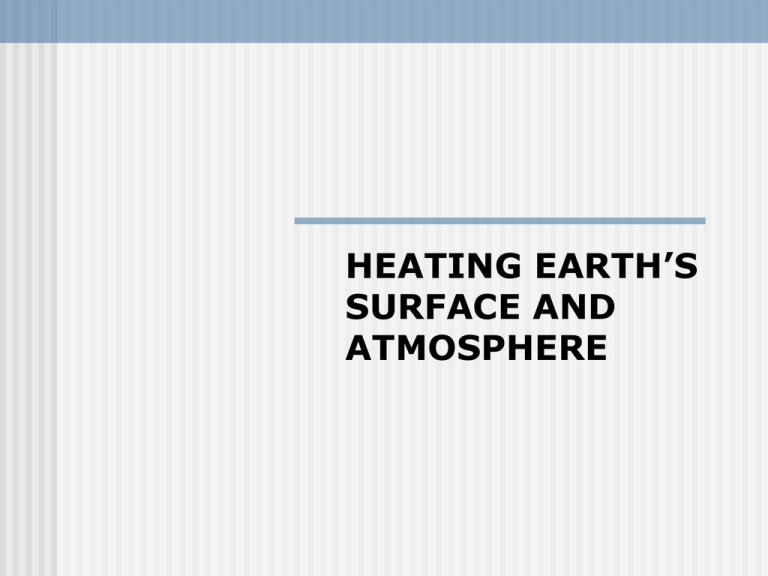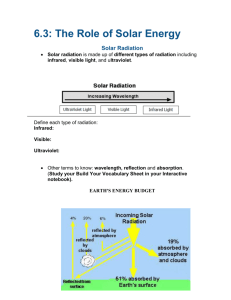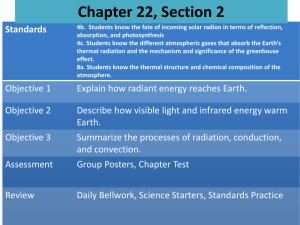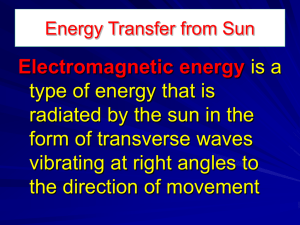Weather & Climate Chapter 2
advertisement

HEATING EARTH’S SURFACE AND ATMOSPHERE INTERESTING The sun radiates to the Earth phenomenal amounts of energy, too much, in fact… We term this quantity of energy the solar constant [2.0 cal/cm2min or 3.1x1012 cal/mi2-hr] INTERESTING, cont To give this a context, an adult sunbather would absorb 6000 cal/min at this rate. In 30 minutes he/she would absorb 180,000 cal… enough energy to heat 10 cups of water from room temperature to boiling …. Luckily, <50% of solar radiation reaches the Earth’s surface It has long been recognized that the Earth maintains an approx. 364 day revolution around the sun as it makes an approx. 24 hour rotation on its axis (our day) Additionally, the Earth is inclined approx 23 ½o from perpendicular and towards the plane of the ecliptic (our seasons and our year) Earth intersects less than two billionths of the sun’s radiation … even this is more than we need … this energy is not even distributed, being variable by: (1) latitude-diffused from 30o to 90o (2) time of day/year-affects solar intensity and volume of atmosphere passing through Mechanisms of Heat Transfer Radiation Conduction Convection / Advection Latent Heat of Condensation Mechanisms of Heat Transfer Radiation – the “laws” (1) all objects emit energy over a range of wavelengths (2) hotter objects radiate more total energy (3) the hotter the body, the shorter the wavelength emitted (4) good absorbers are good emitters Mechanisms of Heat Transfer, cont Conduction – molecule-to-molecule energy transfer most efficient in densely “packed” molecules Convection – energy transfer through expansion of a substance convection – vertical; advection - horizontal Mechanisms of Heat Transfer, cont Latent heat – a potential heat available for absorption (into a substance) or release (into the atmosphere) What Happens to Incoming Solar Radiation? Reflection – direction change due to contact with another surface --- reflected at same angle --- no heating of atmosphere occurs --- energy generally lost to Earth use Albedo – that portion of incoming radiation reflected by a surface … affected by color and composition What Happens to Incoming Solar Radiation?, cont Scattering – occurs when incoming solar radiation is forced to change direction by contact with gas molecules in the atmosphere --- wavelength does not change --- radiation with shorter wavelengths are most affected … thus, blue skies and orange at sunset and in pollution What Happens to Incoming Solar Radiation?, cont Absorption: (1) atmospheric – by gas molecules / aerosols / particulates --- atmosphere in general is not good absorber --- visible light not well absorbed What Happens to Incoming Solar Radiation?, cont (2) terrestrial – absorbed by Earth surface (and man-made) - most is re-radiated as infrared terrestrial radiation - Thus, the Earth heats the atmosphere - Most of this radiation is lost back to space, concern of greenhouse effect (good and bad) Average Breakdown of Insolation Absorbed by atmosphere – 19%-22% Reflected into space – 34% Absorbed Earth surface – 43%-47% Factors Effecting Insolation to the Ground Latitude - tropical zone - mid-latitude zone - polar zone (2) Length of Day (3) Atmospheric Conditions (1) Heat Budget – term for the balance between energy gained through insolation and lost through radiation / reflection back to space Heat Energy Budget Insolation to the Ground 47% of incoming solar radiation reaches the surface of the Earth … ultimately returned to the atmosphere terrestrial radiation – 14% conduction/convection – 10% latent heat – 23% Variation in the Heat Energy Budget Regions of Energy Surplus --- tropical zones --- seasonal Regions of Energy Deficit --- polar zones --- seasonal







